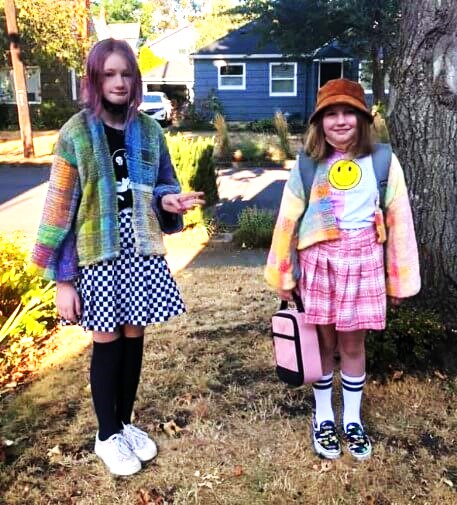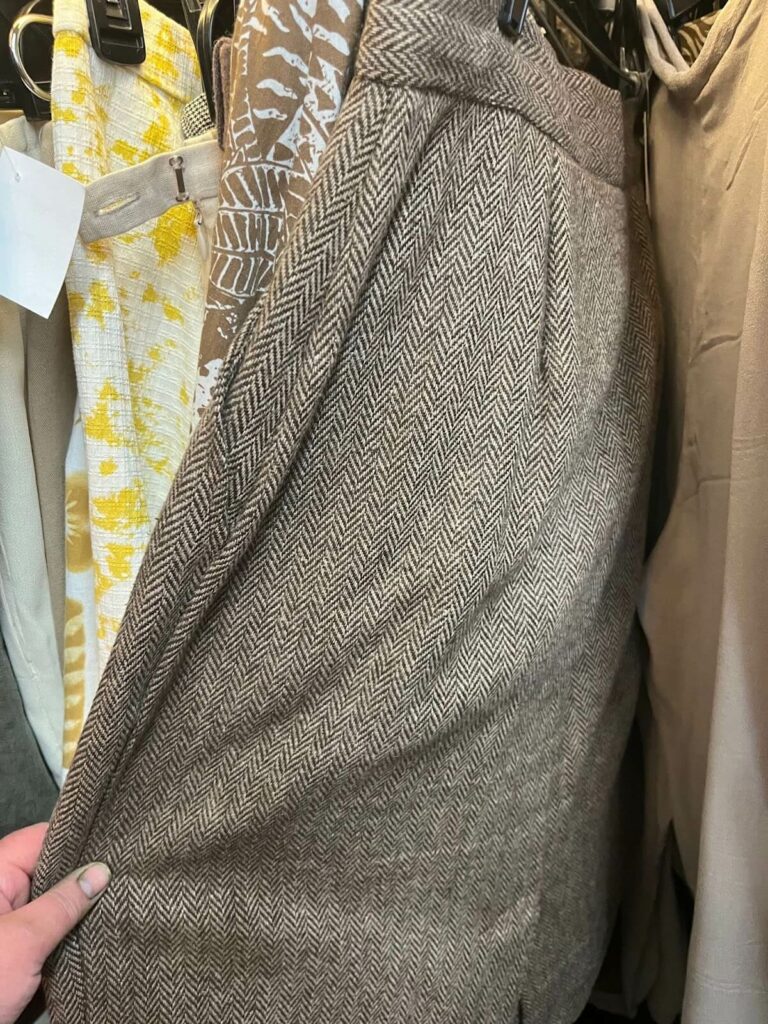Sewing handwoven fabric is a common goal for many weavers. It would seem that making cloth and then making clothes from it would be a natural combination, like peanut butter and jelly, but it’s surprisingly hard to connect the two. I am a long away from being a master at weaving my own garments, but I do have a lot of experience sewing my own clothes and costumes. With this experience, I can offer some advice from someone who is not yet an expert but has had some success sewing my own handwoven cloth. Because the subject is so vast, I thought it would be helpful to offer some step-by-step actions you can take to get you on the road to designing your own handwoven garments.

Believe it not, they asked me to make them these cuddly jackets! And wore them to school!
The first step of this journey will sound a bit cheeky but I mean it in all earnestness.
- If you don’t know anything about sewing, learn how to sew first.
- If you know only a little about sewing, learn a bit more about it.
- If you know a LOT about sewing, then…get weaving! You are already ready to sew your own cloth.
If you’re just getting started or haven’t sewn in a long time, sign yourself up for a beginner’s sewing class. Sewing machine dealers sometimes offer sewing classes for free to help you learn to care for and use for your new purchase. Beginning classes typically have you make a simple item like a tote bag, pajama bottoms, or a pillowcase out of plain weave cotton fabric. You should learn the basics of how patterns work, how to sew, press and finish your seams and how to thread and maintain your sewing machine. If you don’t have anyone teaching locally, there are many, many classes online. Some community colleges offer beginning sewing classes in their community education offerings and be sure to check the large craft and sewing chains to see if they have any free or cheap classes.
Sewing, like weaving, is its own rabbit hole. How far you want to travel down that hole is dependent on how much enjoy it and how complex you want your final projects to be. If your goal is to make bespoke tailored jackets (or a wedding dress like Tien) you need to invest much more time in learning to sew and tailor.
The next step to sewing your handwoven cloth is easy: take yourself clothes shopping. But don’t worry, you don’t need any money for this kind of shopping. What you are doing is looking for inspiration.

Visit stores that have styles you love, even if you can’t afford to shop there usually. You are searching specifically for apparel that has two qualities: it’s a style you would wear and it’s made from fabric you know you can weave. I take detailed photos of the fabric and item so I have a reference later. These images will help when you design your handwoven garments later on.
What do you observe? Can you find clothing in fabric you can weave in styles you would actually wear? Are the garments fitted or loose and draped? What fiber is the garment made out of? What colors are you drawn to? What woven structures are commonly found in apparel? You might be surprised just how much is made from a simple plain weave or 4 shaft twill, like the skirt in the photo to the left.
After you have a good understanding of some sewing techniques and inspiration to design the fabric you will weave, you are ready to sample your weaving and select a sewing pattern.
I used to draft my own patterns, but commercial patterns have become much more reliable in recent years and there are many small pattern designers to order from. Some even focus on handwoven fabrics- Like Sarah Howard and Daryl Lancaster. I search for patterns that have fewer seams and don’t require technical tailoring, buttonholes or zippers, set in or puffed sleeves and collars. This pattern from Sew House 7 is a good example of something I would look for: simple lines, comfortable fit, and raglan sleeves. This jacket from Burda would be a great option as well with its simple pieces, customizable length, and optional buttons or ties.


After you select your pattern, make a test version, usually called a muslin, to work out any kinks. Muslin refers to the plain, inexpensive cotton test garments were traditionally made from, but I prefer to make my samples from an attractive commercial cloth I would wear so I can keep it or donate it when I am done sewing the pattern.
Commercial cloth is 45-60” wide cloth and that makes many weavers think they need a 45”-60” wide loom if they want to sew their weaving into clothes. You don’t! Your loom only needs to be as wide as the widest pattern piece. For shirts and pants and narrow skirts, a 20”-24” loom is usually sufficient. If I need a panel wider than what my 24” loom can weave, I add a seam and divide the pattern piece into two pieces. This means you will need to weave a piece long enough for all the pattern pieces, not the yardage listed on the pattern. Measure all your pieces end to end, add the numbers to find your needed fabric length after shrinkage. I weave extra, at least 18” or more to allow for weaving errors and extra shrinkage after finishing.
If weaving many yards of fabric for a project is overwhelming, remember that there is no rule that requires you to weave enough fabric for a full garment.
Using commercial fabric, with a panel of handwoven cloth makes for an interesting garment, showcases your work, and can keep the piece from being too heavy.
In this dress I had just enough of this plain weave to use as an accent for this easy silk pullover dress.

In general, I find sewing handwoven cloth isn’t much different from sewing commercial cloth, especially if you weave at higher setts and have fabric that behaves and looks more like what you find in the fabric store.
If your handwoven fabric is thick or loosely woven, you might find it more challenging to sew, and ensuring that the fabric doesn’t unravel as you manipulate it is important.
Using a woven fabric that is heavily patterned, like an overshot design is similar to using a commercial fabric with a bold print. It can become a fabulous finished garment, but it takes a little more planning and creativity to get there.
If you are working with this type of fabric, or something that is heavy or thick, it can be a challenge to pair the fabric with a pattern successfully. I find it helpful to go to the apparel industry for inspiration and see if they are using something similar. But this isn’t unique to handweavers, in my years of sewing, selecting the right pattern with the appropriate cloth is always a bit of a learning process and it takes time and experience.
The only other difference between handwoven and commercial cloth is learning to manage fabric that wants to unravel or pull out of shape. It is a big help to learn appropriate seam finishing and stabilization techniques. There are many methods to doing this: from using fusible web, overlocking stitches, hand over casting, encasing the edge in bias tape… more than we can cover in a single blog. The one thing you need to remember is that there are many ways to achieve a good finish that will withstand washing and wearing and every sewer has their favorite methods. No technique is right or wrong, as long as it works. Try a few seam finishes on some sample cloth and wash them a few times and learn what works for you.
My last bit of advice is also going to sound a bit cheeky. You really don’t need to sew to wear your weaving. I fill my closet with simple black garments and drape myself in shawls, scarves, cowls, and ponchos. Often my machine is used only to add a simple seam to transform a rectangle into a poncho or cocoon coat or hem some towels. I also like making small items like shoes and bags and pillows, sewing doesn’t need to result in a full garment.

Hopefully, this article will inspire you to start sewing with your own handwoven fabric. Please share your progress with us! We can’t wait to see what you design.
From the Course Catalog:

Double Density threading on the Rigid Heddle – Weaving with a higher density can help you weave fabric for clothing.

The Design Process – This class breaks down the design process, so you can weave the fabric that you want.
From the Weavers Toolbox:

Warp yarn required – Calculate how much yarn you need for your warp.

Weft yarn required – Calculate how much yarn you need for your weft

